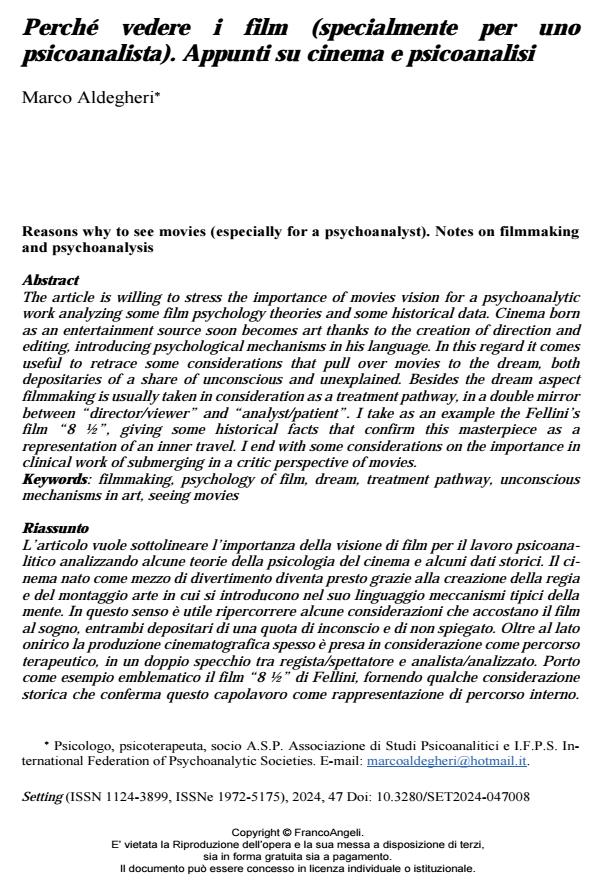Perché vedere i film (specialmente per uno psicoanalista). Appunti su cinema e psicoanalisi
Titolo Rivista SETTING
Autori/Curatori Marco Aldegheri
Anno di pubblicazione 2024 Fascicolo 2024/47
Lingua Italiano Numero pagine 14 P. 125-138 Dimensione file 188 KB
DOI 10.3280/SET2024-047008
Il DOI è il codice a barre della proprietà intellettuale: per saperne di più
clicca qui
Qui sotto puoi vedere in anteprima la prima pagina di questo articolo.
Se questo articolo ti interessa, lo puoi acquistare (e scaricare in formato pdf) seguendo le facili indicazioni per acquistare il download credit. Acquista Download Credits per scaricare questo Articolo in formato PDF

FrancoAngeli è membro della Publishers International Linking Association, Inc (PILA)associazione indipendente e non profit per facilitare (attraverso i servizi tecnologici implementati da CrossRef.org) l’accesso degli studiosi ai contenuti digitali nelle pubblicazioni professionali e scientifiche
L’articolo vuole sottolineare l’importanza della visione di film per il lavoro psicoanalitico analizzando alcune teorie della psicologia del cinema e alcuni dati storici. Il cinema nato come mezzo di divertimento diventa presto grazie alla creazione della regia e del montaggio arte in cui si introducono nel suo linguaggio meccanismi tipici della mente. In questo senso è utile ripercorrere alcune considerazioni che accostano il film al sogno, entrambi depositari di una quota di inconscio e di non spiegato. Oltre al lato onirico la produzione cinematografica spesso è presa in considerazione come percorso terapeutico, in un doppio specchio tra regista/spettatore e analista/analizzato. Porto come esempio emblematico il film “8 ½” di Fellini, fornendo qualche considerazione storica che conferma questo capolavoro come rappresentazione di percorso interno. Concludo con alcune considerazioni sul rilievo nel lavoro clinico di immergersi in un’ottica critica del cinema.
Parole chiave:cinema, psicologia del cinema, sogno, percorso terapeutico, meccanismi inconsci nell’arte, vedere film
Marco Aldegheri, Perché vedere i film (specialmente per uno psicoanalista). Appunti su cinema e psicoanalisi in "SETTING" 47/2024, pp 125-138, DOI: 10.3280/SET2024-047008